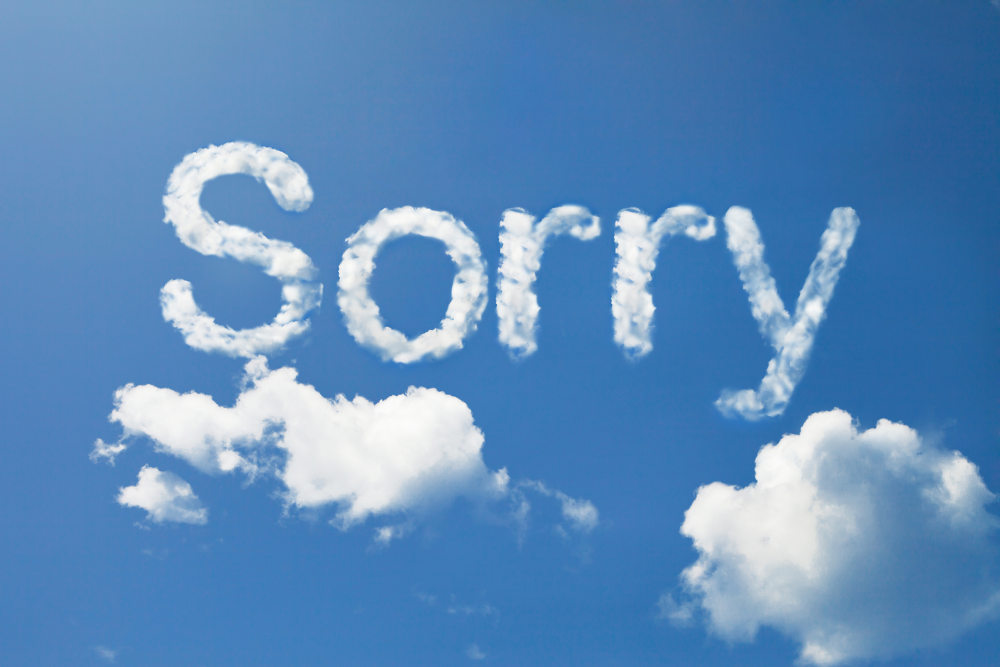
Here is a cautionary tale: United Airlines stock drops $1.4 Billion after a passenger-removal controversy.
We all know that as children, we are taught the laws of forgiveness and encouraged to verbalize three simple words that are often the hardest to say, “I am sorry.” No one likes to admit when they’re wrong. It makes us feel vulnerable, exposed, and defenseless. We have a hard time putting down our armor long enough to see what we’ve done to the other person. As we move from the playgrounds of childhood to the “work grounds” of adulthood, uttering those three words doesn’t get any easier.
Why are apologies necessary in business?
Relationships are the bedrock of your business, and apologies mend relationships damaged by mistrust. Ethics expert Jim Lichtman, as quoted in Why We Talk, commented, “In business and public life today … the thing you erode away faster than anything else is trust. Once the credibility is gone … you’re going to have to work two, three, four times as hard to get it back.”
This echoes conventional wisdom that it takes years to build up trust, and only seconds to destroy it. With such odds stacked against companies, how can they repair relationships and win back the trust of their customers?
The Power of the Pardon
Jennifer Robbennolt, professor of law and psychology at the University of Illinois College of Law, studied the relationship between apologies and legal settlements. In her experimental study, participants were asked to read a vignette describing an accident in which they were injured in a collision with a bicyclist and offered a settlement that covered their medical expenses.
Robbennolt found that when the bicyclist didn’t apologize, 52 percent of subjects indicated they would accept the monetary settlement. When the bicyclist gave a full apology and took complete responsibility for the accident, 73 percent of subjects accepted the offer (a 21-percentage point increase compared to receiving no apology). More interestingly, when the bicyclist offered a partial apology, expressing sympathy but not accepting fault for the accident, only 35 percent of subjects accepted the settlement.
In other words, full apologies are better than partial apologies, but partial apologies may be worse than no apology at all.
The Art of the Apology
Trusted brands are just as susceptible to lapses in judgment as any other brand. One difference prevails: they’re not afraid to admit when they’re wrong. They acknowledge their offenses, are slow to blame others, and often take full responsibility for their actions. To these brands, nothing less than a full apology will do.
The DVD-by-mail company Netflix sent an email on March 26, 2008, to their customers with the subject line “We’re sorry your DVD was delayed.” Netflix encountered an unexpected problem in their system, delaying their shipment of DVDs by one day. They apologized for the inconvenience and automatically issued a 5% credit to every customer’s account. Now, this minor glitch may have fallen under the customer’s radar, but the admission by Netflix was guided by higher principles of integrity and truthfulness, which further solidified a customer’s sense of loyalty to the brand.
Steve Jobs, CEO of Apple, was bombarded with emails from customers expressing their consternation about the sudden $200 price drop two months after the iPhone hit the market. The die-hard early adopters felt shafted and wanted their voices to be heard. Jobs acknowledged the oversight, “We need to do a better job taking care of our early iPhone customers as we aggressively go after new ones with a lower price. Our early customers trusted us, and we must live up to that trust with our actions in moments like these.” Jobs then offered a $100 store credit to those early iPhone buyers, with a sincere apology and a claim for wanting “to do the right thing.”
Southwest Airlines has taken a dynamic approach to handling the myriad frustrations intrinsic to air travel. As Senior Manager of Proactive Customer Communications, Fred Taylor Jr. has mastered the art of the apology. Taylor devotes his workdays finding out how Southwest disappointed its customers—in flight delays, lost luggage, diverted landings—and takes proactive measures to remedy the situation, sending out earnest letters of apology within 76 hours of the event.
Taylor believes that “an apology provides the opportunity to offer the customer assurance that you care about their feelings.” Taylor threw out the form letter because “cookie-cutter responses water down your product,” and replaced it with a “heartfelt, homespun correspondence” peppered with personal touches.
In a real life example of Robbennolt’s study, Taylor understands that a partial apology doesn’t hold a candle to a full apology, because people, whether a customer or an accident victim, have finely tuned radars for insincerity It’s those customer service calamities with high emotional impact—laden with frustration, irritation, and anger—that leave an indelible mark in our memories. Companies have a choice. They can get defensive, use denial, play ignorant, or take the higher road and utter those three simple words.
Remember: It’s not just an apology, but an apology that comes straight from the heart, that will be the salve for your transgressions, no matter how big or small.
And yes, apology accepted.
***
See the full experimental study: Robbennolt, J. (2003). Apologies and legal settlement: An empirical examination. Michigan Law Review, Vol. 102, pp. 460-516.
